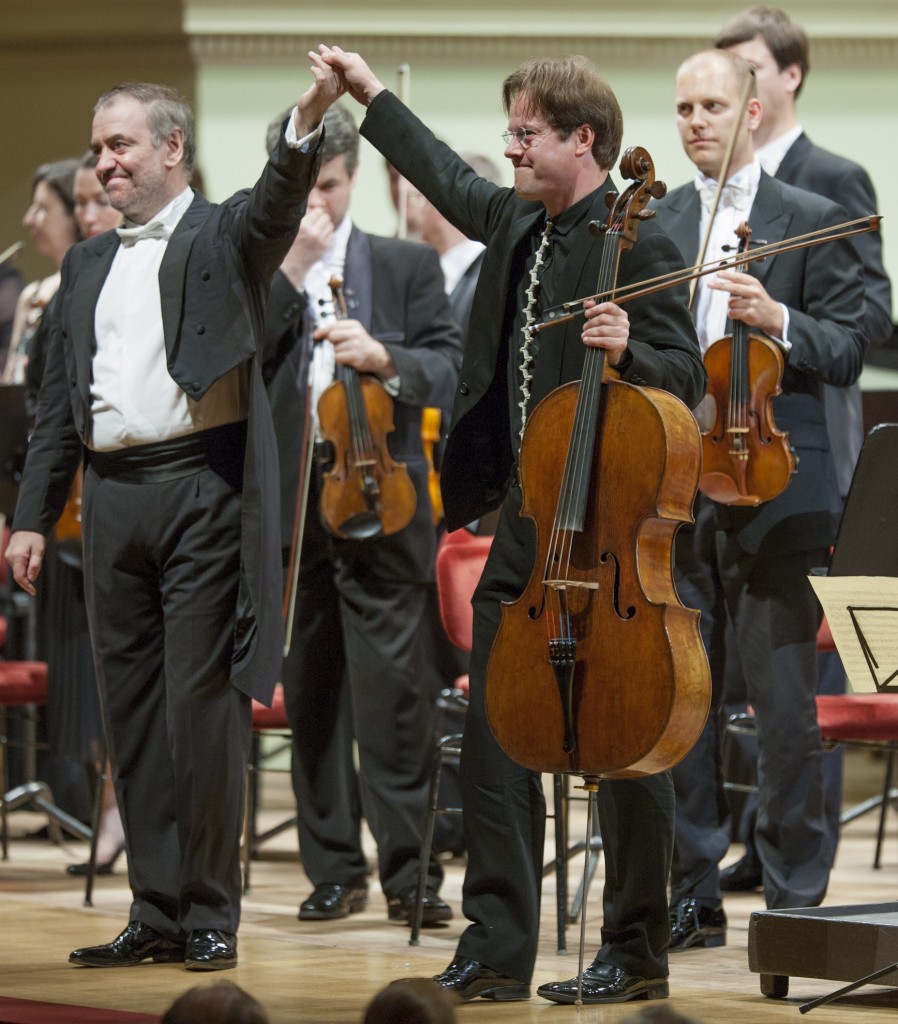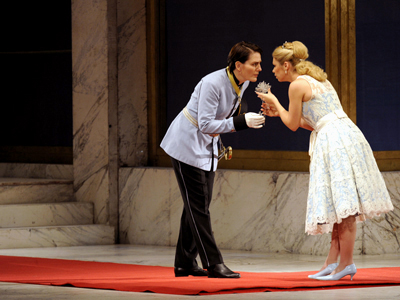By Rebecca Schmid
The theme of this year’s Dresdener Musikfestspiele, “Herz Europas” (the Heart of Europe), inventively returns the East German city to its roots as a thriving cultural hub. While today’s united Germany is roiled by the end of the ‘Merkozy’ era and Eurobond controversy, the emphasis of the festival (May 15-June 3) on central European repertoire and the cultural proximity of Dresden to the former Hapsburg Empire in effect harks back to a time when the arts served as a better common currency than any fiscal pact. As the Intendant and cellist Jan Vogler pointed out in a discussion, no other part of the world has produced a more influential body of composers than Eastern Europe. Vogler, who took over the festival in 2009, has turned a once provincial institution into an international attraction boasting a roster of coveted artists and ensembles. At the same time, he strives in his programming to strike a balance between the local love of native tradition and a more outward-looking approach. While last year’s theme, “Stars of Asia,” must have seemed positively exotic for the conservative ‘baroque’ city, Vogler—who spends most of the year in New York—hopes to provide a kind of ‘double-window’ from Dresden into international trends and vice versa.
The city of former East Germany has received a face lift in recent times, from the reconstruction of the Frauenkirche in 2005 (sixty years after the Protestant church was bombed to the ground) to Daniel Liebeskind’s provocative redesign to the Museum of Military History—a wedge of concrete and steel that slices through the traditional architecture—last year. Boxy post-war buildings line the outskirts of the shell-shocked city while fancy new hotels abut the cobblestone streets of the city’s small but opulent center, where the rebuilt Semperoper stands as a monument to the heyday of late German Romanticism (the original 19th-century building premiered works by Strauss and Wagner). The resident orchestra, the Staatskapelle Dresden, has already cemented its relationship with the incoming Music Director Christian Thielemann—who, according to Vogler, may have filled Karajan’s shoes as a leading conductor for many in Germany, unfortunate political allusions aside.
MatthiasCreutziger.jpg)
The program notes to a performance of Bruckner’s Eighth Symphony, presented as a co-production of the Staatskapelle and the festival, go as far as to compare the collaboration to a fated marriage, with the symphony acting as testimony. While a couple of my colleagues from the Music Critics Association of North America found the performance lacking a sense of arch at the expense of attention to dynamic detail, it is hard to deny the authenticity Thielemann brings to this music, with its triumphant Wagnerian brass and inner torment. Performing a 1939 edition that melds Bruckner’s original score with a modified version he penned between 1887 and 1890, the young Karajan kept the orchestra flowing like a well-oiled machine, with the Staatskapelle’s strings providing a full-bodied sound reminiscent of the Vienna Philharmonic. As a tuba solo hovered over a rising string motive in the final movement Feierlich, nicht schnell (a passage not included in the original score), history seemed to stand still.
To be sure, Dresden cannot as easily rest on its laurels as the long established Salzburg or Bayreuth festivals, yet the former imperial city of Saxony boasts its own lineage of noble interest in the arts. Princess Amalie, daughter of Prince Maximillian and the Princess of Parma, wrote a total of twelve operas based on her own libretti between 1816 and 1835, the last of which—La Casa Disabitata—was retrieved from an archive in Moscow with rights to a single unstaged performance at a 17th-century Lusthaus in Dresden’s Großer Garten this year. The grounds remain largely untended and the salon unrestored, yet the faded glory provided a fitting context for this mock opera buffa involving an orphan, Annetta, who is given shelter in a vacant house owned by the nobleman Don Raimondo where the poor poet Eutichio has secretly taken refuge. In the end, Raimondo and Annetta are finally able to acknowledge a mutual crush, while Eutichio and his wife Sinforosa also overcome their differences.
The plot is somewhat half-baked, and the music can be succinctly described as a rehashed Mozartean farce with shades of Cimarosa and Rossini. Amalie’s attempt to extend the formulaic final coda may reveal a poor grasp of dramatic tension, but at least she had the good taste to resist the lure of courtly indolence by immersing herself in the Mozart-Da Ponte masterpieces. Eutichio even breaks out into a meta-dialogue between Don Giovanni and the Commendatore before Annetta bursts in with her new keys while the poet waves a plastic pistol in his defense. As Eutichio, Matthias Henneberg was a bit of the sore thumb in a cast of otherwise budding young singers as he struggled to tailor his mature bass to the small resonant space. The lyric soprano Anja Zügner gave a stand-out performance as Annetta; Tehila Nini Goldstein (Sinforosa), Allen Boxer (Callisto, the house caretaker) and Ilhun Jung (Raimondo) also displayed fine musicianship to accompaniment by the Dresdner Kapellsolisten under Helmut Branny.
Just around the bend from the grassy promenades of the Großer Garten sits the monumental ‘Gläsener Manufaktur,’ a largely transparent glass and steel complex erected in 2002 that serves not only as a Volkswagon production plant but an event space. On a small stage beneath suspended half-built sedans with their engine parts exposed (call it factory chic), violiniste du jour Patricia Kopatchinskaja joined with both her parents and two other friends for an evening of gypsy-inspired music from Bartok to Ravel. The contrast of her father’s 120-year-old cimbalom with the industrial surroundings and the faint sound of a machine whirring (apparently an air-conditioner to counteract the heat produced in manufacture) was somewhat jarring for this listener, and Kopatchinskaja’s correction to the program notes that this music should not be considered ‘coffee house’ fare despite the fact that she hopes we can all drink coffee through the economic crisis only drove home the irony, but her ensemble’s spirited, authentic musicianship eventually created a world of its own, culminating in an encore of the full quintet performing to the Balkan dance melody “Hora Stacato.”
Back in the center of town a few days earlier, Steven Devine conducted the Orchestra of the Age of Enlightenment and English tenor Ian Bostridge in an all-Bach program at the Frauenkirche. The acoustics of the church were a bit too fractious for the clear textures of the period ensemble—a colleague noted an approximately four-second reverb—yet the musicians increasingly settled into the space with their signature elegance. Bostridge, opening with a dedication to Dietrich Fischer-Dieskau, gave a tender account of the cantata “Ich habe genug,” although the transcription for tenor did not always flatter his instrument. His timbre found a better match in an aria from the cantata “Lass, Fürstin, lass noch einen Strahl” in which he also revealed impeccable breath control. As no festival would be complete without educational activities, Kristian Järvi was busy rehearsing his Baltic Youth Orchestra together with the MDR Symphony, where he will take over as music director next season. The young musicians, joined by a few professional members, displayed great potential in a performance of Mahler’s Bach Suite at the city’s event space “Messe Dresden,” followed by the MDR in a clean but sorely rushed interpretation of Beethoven’s Eighth Symphony.
Vogler, upholding his commitment to diverse programming, joined Valery Gergiev and the Marinsky Orchestra for his first performance of Honegger’s Cello Concerto, an approximately 16-minute gem that weaves together expressive neo-Romantic lyricism, shades of Gerschwin, and early twentieth-century angst. Vogler shaped the cantilenas expertly and nailed the fast runs of the final movement. Despite the sharply accented style of the Marinsky, Gergiev provided deferential accompaniment, and the music’s precise architecture emerged gracefully. As an encore, Vogler offered a movement from Bach’s Cello Suite in C-major, the lower range of his instrument singing with particular clarity of expression. The concerto was flanked by a somewhat clunky reading of Bartok’s “Miraculous Mandarin” (many noted that Gergiev’s nose never left the score) and Strauss’ “Ein Heldenleben,” which vacillated between the brash and the serene. The orchestra silenced all criticism in an encore of Lyadov’s “The Enchanted Lake,” creating a pianissimo as rich and placid as is earthly possible.
 The Dresdener Musikfestspiele has tapped a wealth of potential with a new festival orchestra joining players from top period ensembles such as the Academy of Ancient Music, Concentus Musicus Wien and Il Giardino Armonico, which premiered under Ivor Bolton just after I’d made my way back to Berlin. Vogler also let on that Britten’s centenary will receive some deserved attention next year (the Semperoper has no plans to the effect), including the “War Requiem” with Andris Nelsons and the Birmingham Symphony. Dresden can of course also boast its share of extra-musical attractions, which will surely continue to work to the festival’s advantage. The Alte Gemälde Galerie boasts striking paintings of an intact city by the Venetian artist Canaletto, a sizeable collection of Dutch masters and just launched an exhibit with Raphael’s “Sistine Madonna” at its centerpiece. The local wine industry, despite its northern location, produces a Gold Riesling on par with Alsatian vineyards. As it happens, the Herald Tribune ran a travel story last week about Dresden’s move away from its communist past (always a newsworthy bit) and toward a vibrant cultural life: perhaps the Elbe is indeed bringing in fresh wind again.
The Dresdener Musikfestspiele has tapped a wealth of potential with a new festival orchestra joining players from top period ensembles such as the Academy of Ancient Music, Concentus Musicus Wien and Il Giardino Armonico, which premiered under Ivor Bolton just after I’d made my way back to Berlin. Vogler also let on that Britten’s centenary will receive some deserved attention next year (the Semperoper has no plans to the effect), including the “War Requiem” with Andris Nelsons and the Birmingham Symphony. Dresden can of course also boast its share of extra-musical attractions, which will surely continue to work to the festival’s advantage. The Alte Gemälde Galerie boasts striking paintings of an intact city by the Venetian artist Canaletto, a sizeable collection of Dutch masters and just launched an exhibit with Raphael’s “Sistine Madonna” at its centerpiece. The local wine industry, despite its northern location, produces a Gold Riesling on par with Alsatian vineyards. As it happens, the Herald Tribune ran a travel story last week about Dresden’s move away from its communist past (always a newsworthy bit) and toward a vibrant cultural life: perhaps the Elbe is indeed bringing in fresh wind again.

MatthiasCreutziger.jpg)
